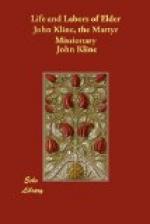Notice the difference. The Lord did not say to him as he had to many others: “Fear not.” This seemed to be his cherished phrase to all who loved and believed on him. To the women at the sepulcher, these words, “fear not,” were addressed by the angel. To the church, seen in vision by the prophetic eye of Isaiah, the words, “Fear not, for I have redeemed thee: fear not, for I am with thee,” are tenderly spoken by the Lord. If Saul’s conviction had been brought about by human agency through the preaching of the Word, the adversaries of the cross might have said that he had been persuaded, or bribed with money to change his manner of life. But nothing like this could be said now. The men who journeyed with him could testify otherwise. They saw the light that flashed upon him; but they heard not the words spoken. They were not persecutors of Jesus by intention as Saul was. Like the soldiers who nailed the Lord to the cross, they knew not what they did. But Saul knew what he was doing, and the light struck conviction to his heart.
Conviction is a knowledge of sin imparted by the Holy Spirit through the Word. The light that Saul saw is an expressive emblem of the light of revealed truth. Light signifies truth, in very many places in the Scriptures. Take, for examples, the following: “The people which sat in darkness saw great light.” Darkness here does not mean natural darkness, but mental or spiritual darkness, which is ignorance. Again: “Every one that doeth evil, hateth the light.” This was Saul’s state exactly. He was doing evil, and he hated the light to such a pitch of passion that he sought to take the lives of the children of light. But it was God’s way then, and it is God’s way now, to convict and convert men by means of the very thing they hate, which is the Word of Truth.
Saul remained three days and nights in this awful state of conviction in which time “he did neither eat nor drink.” The anguish of spirit suffered during these days and nights no heart but his own can ever know. His sins were red with the blood of the saints. Doubts as to what the persecuted Jesus might require of him, with a thousand unanswerable questions, harassed his mind. Conviction, or a feeling sense of sin, always precedes conversion.




